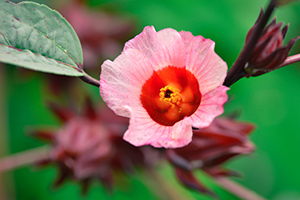Table of Contents
Roselle benefits: Hibiscus is a botanical genus comprising 200 species, many of which are used as ornamental plants in gardens and parks because of their beautiful flowers. From a medicinal point of view, the most used species of this genus are, apart from roselle (species sabdarifa), abelmosk (Hibiscus abelmoschus L.), rose of China (Hibiscus rosa-sinensis L.), and corkwood (Hibiscus tiliaceus L.).
- roselle tea, the ruby of the plant world, the petals are thick, purple red black bright, the blossoms are full, fragrant, red and charming; clean and tender, slice evenly, the soup color is rouge bright. sweet and sour and delicious, let the taste buds dance happily with the heart.

Scientific Facts
- Scientific Name –Hibiscus sabdariffa L.
- Other Names – Jamaica sorrel, guinea sorrel.
- French – Karkadé.
- Spanish – Hibisco.
- Environment – Native to Sudan, it is cultivated in Egypt, Sri Lanka, and tropical areas of Mexico.
- Description—This shrub of the Malvaceae family grows up to two meters high. Its leaves have three to five lobules and yellow or reddish flowers.
- Parts of the plant used medicinally – The flowers with their calyx.
Roselle Benefits

The sepals of roselle flowers contain hibiscus acid, a mixture of organic acids (malic, citric, and tartaric), and a red coloring substance with the following properties:
- Invigorating and digestive – Because of their content in organic acids, roselle infusion has a stimulant effect on the digestive function and a stimulating effect on the whole body.
- Mildly laxative—Roselle’s emollient (soothing) properties on the digestive mucous membrane ease intestinal evacuation.
- Diuretic—The roselle flowers have a mild, however practical, diuretic effect, so they are recommended for people suffering from obesity and heart disorders.
- Natural sedative – The mild acid flavor of roselle and the red coloring its flowers give to other substances are two reasons these flowers are used as a natural additive to enhance the appearance and taste of medicinal herbs or prepared meals.
Corkwood

Corkwood (Hibiscus tiliaceus L.) grows in tropical America, where many local names know it. The fibers of its bark are used for rope and sack making, and its leaves are used as fodder. Both the flowers and the bark of the corkwood root have emollient (alleviating the inflammation of the mucous membranes) and laxative properties for the digestive tract.
How to use Roselle
- Infuse a handful of flowers (with their calyx) per liter of water. Sweeten and drink it cold like any soft drink.
Frequently Asked Question
I know roselle tea can help with blood pressure. How does this work mechanistically?
The mechanisms are multi-faceted. It is rich in polyphenols, which have antioxidant and vasodilatory effects (relax blood vessels), helping to lower blood pressure. Research suggests hibiscus may also act as a natural ACE inhibitor, similar to some blood pressure medications.
Can roselle significantly impact cholesterol levels?
Evidence suggests a potential benefit. Studies have shown reductions in LDL (“bad”) cholesterol and increases in HDL (“good”) cholesterol with consumption.
I’ve read about roselle’s antioxidant properties. Which specific antioxidants are most prevalent?
The plant’s primary antioxidants are anthocyanins (responsible for its red color) and various phenolic acids. Anthocyanins are powerful antioxidants linked to protection against cell damage.
Are the health effects the same whether I consume roselle hot or cold?
While more research is needed, both hot and cold preparations likely offer benefits. Heat may slightly degrade some antioxidants, but the impact is likely minimal.
Can roselle aid in weight management?
There’s potential, but it’s not a magic solution. Studies suggest the plant’s extract may influence fat metabolism and reduce fat accumulation. However, a healthy diet and exercise are still crucial.
I have type 2 diabetes. Could roselle help control blood sugar?
Possibly. Studies show it may lower blood sugar levels. However, it’s essential to consult your doctor before using it alongside diabetes medication, as it might necessitate adjustments.
Are there drug interactions to be concerned about with roselle?
It’s possible. The plant could interact with blood pressure and diabetes medications. It’s also suggested to avoid it within two weeks of scheduled surgery due to potential blood sugar interactions. Always consult your doctor about any possible interactions with your medications.
What’s the optimal dosage of roselle for health benefits?
No single optimal dosage exists. Studies have used various amounts. Most people enjoy it as a tea (several cups a day). For concentrated extracts, follow the manufacturer’s instructions.
Are there any known adverse side effects of roselle?
The plant is generally considered safe for most people in typical amounts. However, excessive consumption can cause some stomach upset. It should be avoided during pregnancy.
Where can I find reliable research about roselle’s health benefits?
Reputable sources include:
PubMed (National Library of Medicine): https://pubmed.ncbi.nlm.nih.gov/
Google Scholar: https://scholar.google.com/
Websites of universities and research institutions.
DISCLAIMER: All content on this website is presented solely for educational and informational objectives. Do not rely on the information provided as a replacement for advice, diagnosis, or treatment from a qualified medical expert. If you are pregnant, nursing, or have any preexisting medical concerns, talk to your doctor before using any herbal or natural medicines.
REFERENCES
- George D. Pamplona-Roger, M.D. “Encyclopedia of Medicinal Plants.” George D. Pamplona-Roger, M.D. Encyclopedia of Medicinal Plants. Ed. Francesc X. Gelabert. Vols. 1 San Fernando de Henares: Editorial Safeliz, 2000. 363. Print. [roselle benefits]
- https://www.ncbi.nlm.nih.gov/pmc/articles/PMC3253843/
- https://www.ncbi.nlm.nih.gov/pmc/articles/PMC6262192/
- https://www.ncbi.nlm.nih.gov/pmc/articles/PMC3769317/
Last update on 2024-07-26 / Affiliate links / Images from Amazon Product Advertising API





